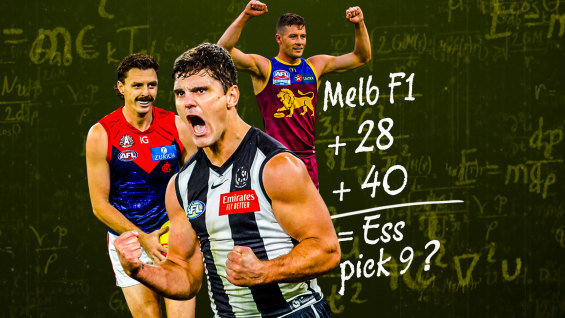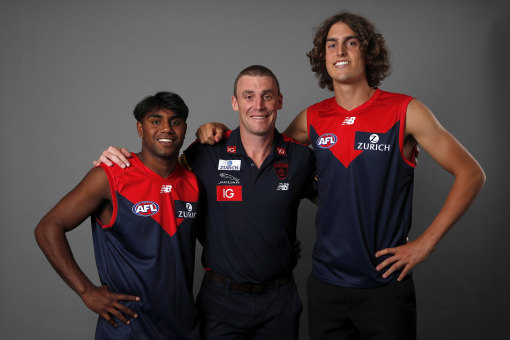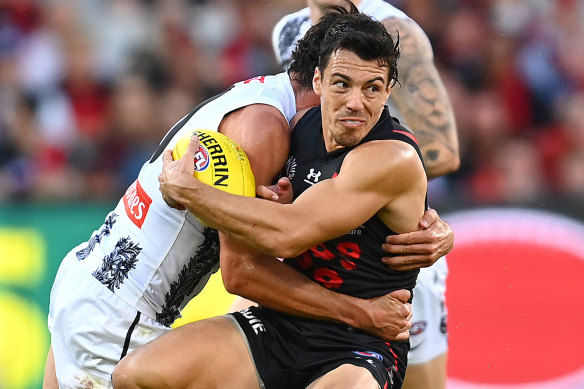Melbourne’s bold move to trade up to Essendon’s pick nine surprised clubs for its audacity as the AFL’s trade period entered its second week, but it’s straight from the Demons’ successful future trading playbook, which has made them the best traders in the first 10 years of the AFL’s future trading system.
The Demons’ ability to predict their own likely finishing position the following season, and therefore accurately forecast what pick they are giving up, has made their future trading success.

Jake Lever, Lachie Shultz and Josh Dunckley are among the players to land at new clubs through future trades.Credit: Jamie Brown/Getty Images
An analysis by this masthead of the first decade of clubs being allowed to trade their picks in the first round of the following year’s draft revealed the Demons had been successful at it, while Collingwood was the most prolific trader of future first-round picks, but also the worst at forecasting the quality of the pick they were parting ways with.
For simplicity’s sake, our analysis was contained to future first-round selections traded, given they are the most valuable.
The Demons will, as this masthead reported on Sunday, give up their future first-round pick and a second-rounder to Essendon for this year’s pick nine. It’s a repeat of their strategy to only trade their future pick when they can secure an early selection in the draft in exchange. They have also previously done well when including future picks in trades for players, as happened with the deals for Jake Lever and Luke Jackson.
In the first year of future trading in 2015, Melbourne cannily tied their future first-round pick into a deal with Gold Coast for pick three in that year’s draft, a pick they used on the player they had targeted, Clayton Oliver. The next year, Melbourne finished 11th so would have had pick eight had they kept their pick.
In 2019, they did the same thing and traded up the draft to secure Kysaiah Pickett. The pick they traded was worth pick 10 the next year.
The Demons also benefited when they agreed to take Fremantle’s future first-rounder as part of the deal for Jackson to move to the Dockers. The next year, Freo performed poorly on-field, finishing 14th, meaning the Demons secured pick five in the draft.
Melbourne traded a future first (and their pick 10) for Lever. The Demons finished fourth the next year, so the future first was not costly at pick 14.
The Demons also traded their future first to Brisbane for picks 18 and 19 in the 2020 draft. In 2021, Melbourne, of course, won the flag, so had they held their 2021 first-rounder it would have been at pick 18. Effectively, the Demons doubled their money.

Melbourne coach Simon Goodwin with Kysaiah Pickett (left) and Luke Jackson in their draft year of 2019.Credit: AFL Photos
The Demons’ success contrasts with Collingwood. Four times in 10 years the Magpies have traded their future first-round pick and each time have finished lower the next year than they had expected, making the pick they traded far more valuable than they had forecast.
The worst trading by a club came in 2020, when Collingwood traded its future first-rounder to GWS for picks 24, 30 and a future fourth-rounder. Collingwood’s future first-round pick ended up being pick two after their disastrous season in 2021, in which they slid to 17th.
Admittedly, just assessing the trade of a future first-round pick is fraught as there are often extra picks involved in exchanges. But because they are the most valuable picks on offer, the trading of future firsts carries the most risk and reward.
Clubs might receive a future second-round pick back for giving up a future first-round pick, so effectively the club slides back in the draft the next year from one round to the next. In some cases, this might only be a few places. That still requires a significant degree of guesswork in trying to predict how clubs will fare the following year.
The best example of this was when West Coast traded their future first to Gold Coast for a handful of picks (21, 26 and 37) in the 2017 draft and the Suns’ future second pick. The Eagles won the flag the next year and Gold Coast was 17th, so effectively the Eagles only slid from what would have been pick 18 to pick 20 in 2018 and got those three picks in the 2017 draft.
Surprisingly, there is no AFL database recording every trade, so the information has to be pieced together.
The analysis also does not consider the variation between the quality of drafts. This year, for instance, is considered by recruiters to be a good draft with many high-talent players compared with next year’s, which is a shallow pool. Thus, a pick 20 in this draft is roughly considered the equivalent to a top-10 pick in next year’s draft.
Consequently, many clubs are offering deals involving future first-round picks this year to Gold Coast in exchange for the available pick 13. This might be one occasion where Collingwood would be right to trade their future first, depending on the detail of the deal.

Essendon midfielder Dylan Shiel.Credit: Getty Images
A complicating factor is what is happening with Gold Coast’s picks, and Essendon agreeing to trade pick nine because they are accruing later draft picks for the points attached to them, so they can match bids for academy players. The same will happen with the Lions, who want to match any bid for father-son nominee Levi Ashcroft. This is where, in practice, the draft splits to effectively have clubs working with two different currencies.
In 2015, Collingwood traded a first-round pick and a future first-rounder for Adam Treloar, only to then have a poor season in 2016, in which their future first-rounder turned into pick seven for the Giants. And last year the Magpies, reigning premiers at the time, traded a future first-round pick to Fremantle for Lachie Schultz, a pick that turned into selection 10 for the Dockers before compensation picks were added.
In 2018, Collingwood also traded pick 18 (in the knowledge they had Isaac Quaynor coming in as an academy product) and their future first-round pick to Brisbane for Dayne Beams. The Magpies finished fourth in 2019 so that would have been pick 15, which pushed out to pick 18 after a priority pick and two NGA players (Port took Mitch Georgiades with that pick). But where they finished didn’t matter much; Beams played only nine games in 2019 before retiring.
Carlton contentiously swapped future first-rounders with Adelaide in 2018, the first year of live trading on draft night, when they traded up to get to pick 19 – a selection they used on Liam Stocker. Stocker was later traded to St Kilda.
Essendon traded pick 11 to GWS and their future first for Dylan Shiel. Coincidentally, GWS used that pick 11 on Jye Caldwell, a player who would later be traded to the Bombers. Essendon finished eighth in 2019, so their future first-round pick turned into pick 11. The Bombers did get other picks in the deal, including a future second-rounder.
Adelaide traded a future first-round pick to get Jordan Dawson from the Swans, and he soon became captain of the club.
It was part of a complicated four-club exchange that meant the future first-rounder they traded to Sydney was tied to Melbourne’s finish in the 2022 season. Melbourne finished fifth after finals in 2022, so that would have been pick 14.
Next year, the AFL rules will change and clubs will be allowed to trade future picks two years in advance. The first 10 years of future trading says Melbourne will relish the new flexibility, while Collingwood and Carlton would be better to hasten slowly.
Get daily updates on all the AFL trade period action. Sign up for our Real Footy newsletter.